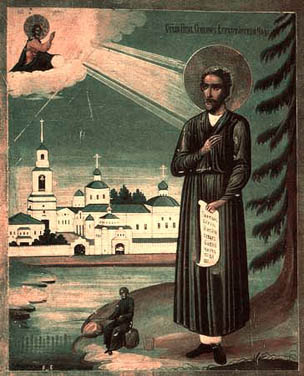
Righteous Simeon of Verkhotursk
Commemorated on September 12 and December 18
Righteous Simeon
of Verkhotursk (+ 1642) was a nobleman, but he concealed his origin and led
the life of a beggar. He walked through the villages and for free sewed
half-coat and other over-clothes, primarily for the poor. While doing this he
deliberately failed to sew something – either a glove, or a scarf, for which
he endured abuse from his customers. The ascetic wandered much, but most often
he lived at a churchyard of the village of Merkushinsk not far from the city of
Verkhotur' (Perm outskirts). Saint Simeon loved nature in the Urals, and
joyfully contemplating its majestic beauty, he would raise up a thoughtful
glance towards the Creator of the world. In such of his time as was free of
toil, the saint loved to go afishing in the tranquility of solitude, since this
reminded him of the disciples of Christ, whose work he continued, guiding the
local people in the true faith. His conversations were that seed of grace, from
which gradually grew the abundant fruits of the Spirit in the Urals and in
Siberia, where the saint is especially reverenced.
Righteous Simeon of
Verkhotursk died in 1642, when he was but 35 years of age. He was buried in the
Merkushinsk graveyard by the church of the Archangel Michael.

On 12 September 1704,
with the blessing of the Tobol'sk metropolitan Philothei, the holy relics of
Righteous Simeon were transferred from the church of the Archistrategos Michael
to the Verkhotursk monastery in the name of Saint Nicholas.
Righteous Simeon
worked many a miracle after his death. He frequently appeared in a dream to the
sick and healed them, and he brought to their senses those fallen into the
disease of drunkenness. A peculiarity in the appearance of the saint was that
with the healing of bodily infirmities he gave instruction and guidance for the
soul.
The memory of
Righteous Simeon of Verkhotursk is celebrated also on 18 December, on the
day of his glorification (1694).
© 1996-2001 by translator Fr. S. Janos.